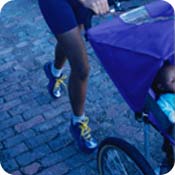 The current medical guidelines regarding when it is safe to begin postpartum exercise have relaxed since the stricter 6-8 week "no exercise" mandate. As with every pregnancy, each woman will have her own, unique experience, and her postpartum, recovery rate will depend on factors related to her health and any complications that may have occurred during delivery. It's always a good idea to talk with your doctor before starting any fitness program postpartum to make sure your body is ready for exercise. When any incisions are healed and you feel ready to get moving keep in mind that you need to listen to your body, and start slowly with gentle progression of exercise intensity and duration.
The current medical guidelines regarding when it is safe to begin postpartum exercise have relaxed since the stricter 6-8 week "no exercise" mandate. As with every pregnancy, each woman will have her own, unique experience, and her postpartum, recovery rate will depend on factors related to her health and any complications that may have occurred during delivery. It's always a good idea to talk with your doctor before starting any fitness program postpartum to make sure your body is ready for exercise. When any incisions are healed and you feel ready to get moving keep in mind that you need to listen to your body, and start slowly with gentle progression of exercise intensity and duration. Experts at the American College of Obstetricians and Gynecologists say it's OK to gradually resume gentle exercise if you were physically active until giving birth as long as you do not have any complications or conditions that might make exercise dangerous. Most physicians advise against resuming vigorous exercise too soon to allow adequate time for recovery, but there are several gentle exercises (listed below) that are recommended for most women who had a normal delivery, whether vaginal or cesarean. The first few weeks after delivery are busy and tiring, so rest is imperative. But it's also important to keep in mind that getting back into a regular exercise routine as soon as you feel ready will help you recover faster postpartum. The guidelines below will help you return to exercise safely within the first weeks after delivery. The following are exercises that can be done within 24 hours of delivery. These exercises help your muscles start functioning after a cesarean section or vaginal birth. Try to do 10-20 repetitions of each exercise 2-3 times a day. Diaphragmatic breathing (Abdominal tightening on outward breath): Lying on your back, place your hands over your abdomen. Inhale and allow your belly to rise as it fills with air. Exhale through your mouth as you tighten your abs, pulling them in towards your spine. Your stomach should flatten, not bulge, as you exhale. Hut Exercise: Either sit in bed or a chair, or lie on your side in bed and place your hands over your tummy. Take a big breath in, and as you exhale say the word "hut" forcefully. You should feel your tummy tighten as you say "hut" and relax as you inhale. Ankle/foot movements help prevent blood clots after anesthesia. Kegels (Pelvic floor contractions): Can be done in any position. You may add on to the following exercises listed below as tolerated. Be sure to check with your doctor before starting more vigorous exercises. Pelvic Tilt: While lying on your back with your knees bent, tilt your pelvis backward as you tighten your abs and exhale. Try to bring your belly button to your backbone as you push your low back into the mattress/floor. Hold for 5 seconds, inhale, and relax. Stretch out the kinks: Lie on your back with arms and legs out straight, palms up. Bend at the ankles so toes are aiming for the ceiling, tighten thigh muscles and push knees into the bed. Pull your abdominal muscles in and flatten your back. Squeeze your shoulder blades together and elongate your neck. Press your hands back into the bed and hold this for a few seconds, then relax. This allows your muscles to contract isometrically (without changing length), which is safe on the body and provides an easy readjustment to normal posture after birth. Active posture check: Standing - tuck your chin in to elongate the neck, pull your shoulders down and back, tighten your abdominal muscles while pulling your belly into your backbone, tighten your pelvic floor, keep knees soft, and increase the arch in your foot. Bridges: Lying on your back with knees bent, contract your abdominal, buttock, and pelvic floor muscles, and raise hips up off the floor. Hold for 5 seconds and relax down slowly. The farther your feet are from your buttocks the more challenging it will be. Bridging can also be progressed by lifting one leg while up in bridge position - but you must be able to keep hips level to do this. Heel Sliding: Lying on your back, tighten your abdominal muscles and do a pelvic tilt. Slowly slide out one leg at a time while trying to maintain your pelvic tilt. You can progress to sliding both legs out together as long as you can keep the pelvic tilt and not allow the back to arch. Always bring legs back one at a time. Arm exercises: Use a light weight (typically three to five pound dumbbells) for lateral raises, bicep curls, triceps exercises, and push up on your knees or against the wall. You can find several demonstrations of these exercises here. Remember, your body needs time to recover after the challenges of pregnancy, labor and delivery. Caring for a new baby takes a lot of energy and focus, so try not to push yourself too hard or too fast. Start with a gentle exercise program, and as your body becomes stronger you can carefully add more exercises and time to your routine. The best way to safely start increasing your cardiovascular fitness is by walking, so think about taking your baby out in the stroller for short walks. Check to see if there are stroller exercise classes offered in your area or other postpartum exercise classes you can join. It helps to get out and exercise with other new moms; you will benefit both emotionally and physically as well as gain valuable support! |
Postpartum Recovery: The First Six Weeks
Gentle Exercises to Help You Recover
Page 1 of 1






Member Comments